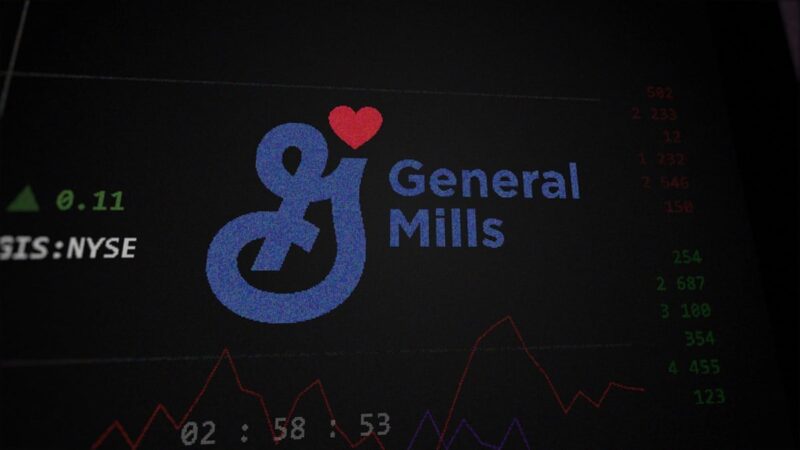GISGeneral Mills$63.71 -0.46 (-0.72%) (As of 06/27/2024 ET)52-Week Range$60.33▼$78.88Dividend Yield3.70%P/E Ratio14.78Price Target$70.72
General Mills NYSE: GIS is the global food manufacturing sector giant known for iconic brands like Cheerios, Yoplait, Pillsbury, and Blue Buffalo. General Mills’ earnings report for the fourth quarter and full-year fiscal 2024 revealed a disappointing performance, which sent General Mills’ stock price downward. Despite a challenging macroeconomic landscape marked by shifting consumer sentiment and persistent inflation, the company demonstrated resilience in certain areas while grappling with headwinds in others.
Get General Mills alerts:Sign UpGeneral Mills Q4 2024 Revenue Falls Short of Expectations
General Mills’ financials revealed that Q4 2024 revenue came in at $4.714 billion. This reflected a 6% year-over-year decrease and fell short of General Mills’ analyst community expectations of $4.85 billion. This decline was attributed to a confluence of factors, primarily lower sales volume and an unfavorable comparison against the previous year’s fourth quarter, which benefited from advantageous trade expense timing. This timing difference created a 3-point headwind to price/mix and a significant 17-point headwind to adjusted operating profit in the recent quarter. However, General Mills management emphasized that these headwinds are largely transitory and that management expects the underlying momentum to improve going forward.
Overall MarketRank™4.64 out of 5 Analyst RatingHold Upside/Downside11.0% Upside Short InterestBearish Dividend StrengthStrong Sustainability-3.28 News Sentiment0.26 Insider TradingSelling Shares Projected Earnings Growth7.71% See Full Details
Despite the revenue decline, General Mills’ earnings report displayed strength in profitability. The adjusted operating profit for the quarter stood at $800 million, representing a 10% decline in constant currency. This decline was primarily due to the trade expense comparison mentioned previously. Excluding this impact, the company delivered solid cost savings through its Holistic Margin Management (HMM) program, which successfully offset input cost inflation and the impact of lower volume. Adjusted diluted earnings per share (EPS) reached $1.01, mirroring the adjusted operating profit decline, with share repurchases counterbalancing higher net interest expense and a slightly higher adjusted effective tax rate.Looking at the full fiscal year 2024, organic net sales contracted by 1% compared to the previous year, which saw double-digit growth. This moderation was driven by lower organic pound volume, partially countered by positive organic price/mix. Segment performance varied, with U.S. Meals & Baking Solutions, U.S. Snacks, and U.S. Morning Foods all experiencing a 2% decline in net sales, while the Canadian market saw a 5% increase. Adjusted operating profit for the entire year climbed 4% in constant currency, bolstered by substantial HMM cost savings, favorable price/mix, and reduced compensation and benefits expenses. However, input cost inflation, higher supply chain costs, and lower volume partially offset these gains.
General Mills’ FY 2025 Guidance and Strategic Priorities
General Mills provided its financial outlook for fiscal year 2025, projecting organic net sales growth to range from flat to a 1% increase. General Mills’ earnings guidance reveals that under constant currency conditions, adjusted operating profit is anticipated to remain flat or decline by 2%, primarily due to a 2-point headwind resulting from the realignment of incentive compensation to targeted levels. Adjusted diluted EPS is anticipated to fluctuate between a 1% decrease and a 1% increase in constant currency. The company remains committed to strong cash generation, aiming for a free cash flow conversion rate of at least 95% of adjusted after-tax earnings.
To navigate the anticipated economic landscape and achieve these targets, General Mills outlined a multi-pronged strategy centered around delivering “remarkable experiences” across its portfolio. This strategy encompasses amplified brand communication, emphasizing consumer-centric messaging and increased media investment across key brands. Examples include a collaboration between Big G cereals and NFL stars, Totino’s partnership with Pete Davidson, and ingredient superiority campaigns for Blue Buffalo pet food and Häagen-Dazs.
Beyond marketing, the “remarkable experience” framework focuses on product innovation, including taste improvements, healthier options, and convenient formats. This translates to initiatives like flakier Pillsbury biscuits, cheesier Annie’s Mac & Cheese, and new varieties of Old El Paso Carb Advantage Taco Shells and Mott’s Apple Streusel Soft-Baked Bars.
Recognizing the importance of value in an uncertain economy, General Mills plans to optimize price points, offer larger pack sizes for certain products, and strategically utilize coupons and targeted promotions. These efforts extend to the Blue Buffalo brand, which aims to regain momentum through targeted advertising, new product launches, and price adjustments.
Enhancing Efficiency: General Mills’ FY 2025 Cost Management Plan
General Mills’ ongoing commitment to cost management through its HMM program is integral to its strategy. The company aims for an impressive 4% to 5% cost savings in its cost of goods sold for FY2025. These savings will be achieved by streamlining operations, leveraging digital tools for greater manufacturing and logistics efficiency, and reducing supply chain complexity.
Despite the challenging environment, the company remains committed to rewarding shareholders. This commitment is evident in the recent announcement of a 2% increase in General Mills’ quarterly dividend, bringing the new rate to $0.60 per share. This move underscores the company’s dedication to balancing strategic investments for future growth with consistent returns for its investors.
General Mills: Balancing Challenges and Opportunities
General Mills faces a complex and volatile landscape marked by evolving consumer behavior, inflationary pressures, and heightened competition. The company acknowledges that regaining consumer trust and market share requires a delicate balancing act.
Despite the challenges, General Mills possesses several advantages. Its portfolio boasts a diverse range of iconic brands with strong consumer recognition. The company’s commitment to innovation, evidenced by its increased focus on taste improvements, healthier options, and convenient formats, positions it to capitalize on evolving consumer preferences. Furthermore, General Mills’ robust HMM program and disciplined approach to cost management provide a buffer against inflationary pressures and empower the company to reinvest in growth initiatives. Investors must closely monitor the company’s ability to translate these plans into tangible results and reestablish itself as a leader in the ever-evolving food industry.Before you consider General Mills, you’ll want to hear this.MarketBeat keeps track of Wall Street’s top-rated and best performing research analysts and the stocks they recommend to their clients on a daily basis. MarketBeat has identified the five stocks that top analysts are quietly whispering to their clients to buy now before the broader market catches on… and General Mills wasn’t on the list.While General Mills currently has a “Hold” rating among analysts, top-rated analysts believe these five stocks are better buys.View The Five Stocks Here If a company’s CEO, COO, and CFO were all selling shares of their stock, would you want to know?Get This Free Report
Like this article? Share it with a colleague.
Link copied to clipboard.








